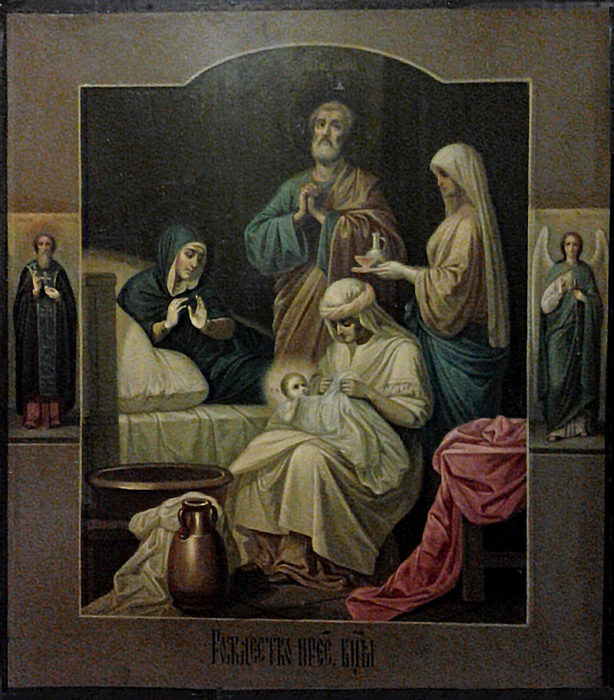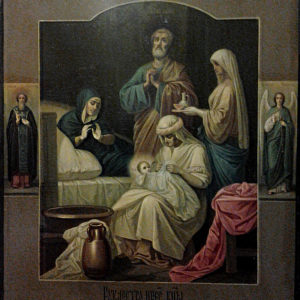
In a few short hours, we’ll be celebrating Christmas, and I wanted to share an insight (based on something that I heard in this Sunday’s homily) that is helping me enter into the spirit of the season more profoundly. What does Christmas have to do with the Eucharist and with the Virgin Mary?
To see the connection, consider the meaning of the feast of Christmas. It is a feast of the Incarnation. In other words, it’s a feast of the Body of Christ. True, Christ became human nine months prior, at the Annunciation, but it’s at Christmas that He enters the world in a more profound way. As St. Thomas Aquinas acknowledges, “Children while in the mother’s womb have not yet come forth into the world to live among other men.” And so today, as Pope St. Leo (400-461) explained,
Let us be glad in the Lord, dearly-beloved, and rejoice with spiritual joy that there has dawned for us the day of ever-new redemption, of ancient preparation, of eternal bliss. For as the year rolls round, there recurs for us the commemoration of our salvation, which promised from the beginning, accomplished in the fullness of time will endure for ever; on which we are bound with hearts up-lifted to adore the divine mystery: so that what is the effect of God’s great gift may be celebrated by the Church’s great rejoicings. [….]
Therefore, when the time came, dearly beloved, which had been fore-ordained for men’s redemption , there enters these lower parts of the world, the Son of God, descending from His heavenly throne and yet not quitting His Father’s glory, begotten in a new order, by a new nativity.
In other words, at Christmas we celebrate how the eternal God took on a human body to save us from sin.
Understood in this light, it should be clear why Christmas is intimately connected with the Eucharist, in which Jesus proclaims, “Take, eat; this is my body” (Matt. 26:26). St. Jerome (347-420) made this connection to Christmas in an ancient homily, in which he asks why Jesus was laid in a manger (Luke 2:7): “Why in a manger? That the prophecy of Isaiah, the prophet, might be fulfilled: ‘An ox knows its owner, and a donkey, its master’s manger.” (Isa.1:3) In another place, it is written: “You save both humans and animals, O Lord.’ (Ps. 36:6) If you are human, eat the Bread; if you are an animal, come to the manger.” Jesus is born in Bethlehem, a city whose name means “House of Bread,” and He immediately takes His place in a food trough.
And of course, the story of the Incarnation cannot be told without talking about the particular role of the Virgin Mary. In perhaps the earliest Christmas proclamation, St. Paul said that “when the time had fully come, God sent forth his Son, born of woman, born under the law, to redeem those who were under the law, so that we might receive adoption as sons” (Gal. 4:4-5). It’s why even those Protestants who ordinarily might be uncomfortable singing hymns about Mary make an exception today to sing, “Silent night, holy night / All is calm, all is bright / Round yon Virgin Mother and Child.” Today, as St. John Chrysostom (349-407) proclaimed in a Christmas homily, “Christ, finding the holy body and soul of the Virgin, builds for Himself a living temple, and as He had willed, formed there a man from the Virgin; and, putting Him on, this day came forth; unashamed of the lowliness of our nature.” In His own homily on the Eucharist, Jesus proclaimed, “I am the living bread which came down from heaven; if any one eats of this bread, he will live for ever; and the bread which I shall give for the life of the world is my flesh” (John 6:51). And that flesh, the flesh we celebrate this Christmas, and the flesh that we receive in the Eucharist, was taken entirely from the Virgin Mary.
All of this is succinctly captured in a beautiful homily from St. Augustine (354-430):
Truth has sprung from the earth, and Justice has looked forth from heaven (Ps 84:12). Truth, which is the bosom of the Father (Jn 1:18), has sprung from the earth, in order also to be in the bosom of his mother. Truth, by which the world is held together, has sprung from the earth, in order to be carried in a woman’s arms. Truth, on which the bliss of the angels is incorruptibly nourished, has sprung from the earth, in order to be suckled at breasts of flesh. Truth, which heaven is not big enough to hold, has sprung from the earth, in order to be placed in a manger.
For whose benefit did such sublimity come in such humility? Certainly for not of his own; but, if we are believers, totally for ours. Wake up, mankind, for your God became man!

Excellent meditations that get to the core of the Incarnation.
Jesus’ birth fulfills Isaiah’s prophesy foretelling God’s desire to be very intimately united to humanity…to us. This is indicated when Isaiah revealed that He would be called ‘Emmanuel’, meaning “God with us’. And, the Incarnation alone would have been a sufficient proof of God’s love for fallen humanity, but who could have imagined that God would perpetuate that Incarnation, generation after generation, until the end of the world via His transubstantiated presence found in the Holy Eucharist? Not only was God made present in the world back 2000 years ago, but He is present today at every Sacred Liturgy today also. What better expression of Divine love can there be than this? It’s mind boggling in it’s Divine charity, care and compassion…and all centered on us…His weak and miserable creatures who He considers to be ‘friends’!
Alleluia!